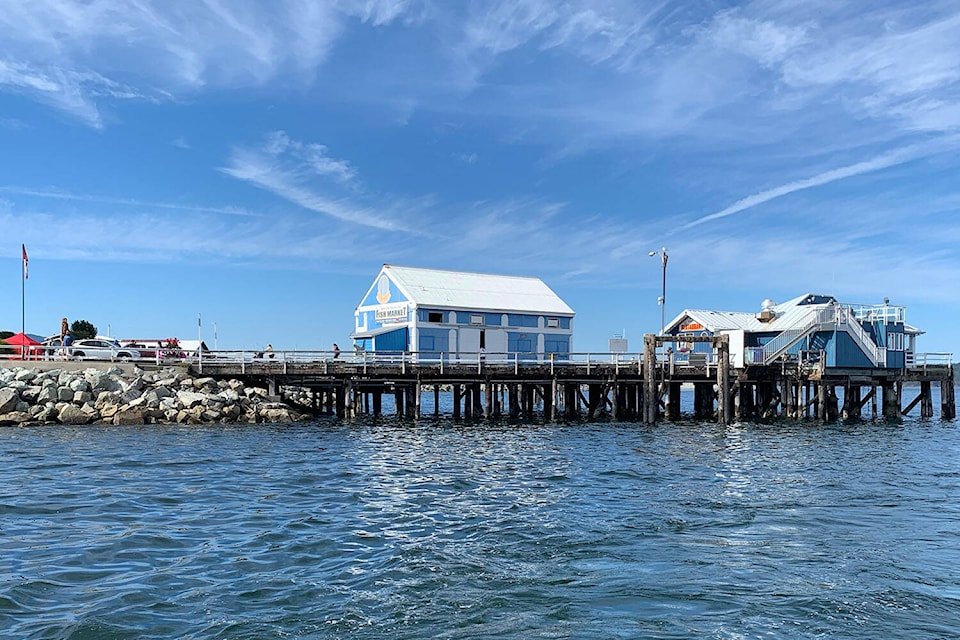A Sidney councillor who recently won re-election has expanded the statements she made about the future of Beacon Wharf before the election.
Coun. Sara Duncan, who is returning to Sidney council, appeared to close the door on refurbishing the existing facility or replacing it with another dock during the Sept. 29 all-candidates meeting.
“In 2024, the leases for the commercial buildings (on the wharf) are up because the dock is essentially going to be unsafe for them to be on,” she said. “It will need to be torn down and re-developed and people have not decided yet. They haven’t been able to grapple with the fact that because of climate change, we cannot build another dock.” She made these comments while answering a question on what moderator Stasia Hartley called the “deferred re-development of the iconic Beacon Wharf.”
Council had voted last year to maintain the wharf for as long as possible without replacing it. A staff report, however, left open the possibility of replacement.
RELATED: Replacement of Sidney’s Beacon Wharf dead in the water, for now
RELATED: Sidney staff report recommends maintaining current Beacon Wharf, for now
The deferral “was the only thing we could do at that time because it is such an emotionally charged issue for our town,” she said. “We cannot build something that will have commercial buildings on it because something like (hurricane) Fiona or tropical storm Ian will take them away before its lifetime is up,” she added later. Sidney needs to build something that still adds what she called vibrancy to the community, “without being the kind of thing that we spend millions of dollars (on) and ultimately cannot keep.”
Duncan’s answer likely raised a few eyebrows, starting with the claim that the wharf “is essentially going to be unsafe” by the end of 2024 when the commercial leases come due and that it “will need to be torn down.” The next assessment of the facility is not scheduled until 2023. That assessment will also determine whether the commercial leases will continue.
When asked later why she deemed the dock to be unsafe before the next assessment, Duncan said all of this information is public. “These condition assessments have always been seen as an interim measure, allowing (Sidney) to keep the existing structure operational until a longer-term option for the waterfront is selected,” she said. “If the wharf were maintained for a few more years, a new condition assessment would be required and this would result in yet another round of repairs. It is estimated that only one more set of smaller repairs would be possible before a much more significant rebuild is required.”
Rebuild in this context means replacement, she added.
While she later acknowledged that another dock could replace the current dock, she said the committee tasked with looking into the wharf’s future had rejected several alternatives because of visual impacts or costs. The public she added, also rejected the public-private partnership proposal to replace it with a floating wharf.
“To reiterate — the dock is over 100 years old, and will be torn down around 2028 due to the fact that we already know it cannot be maintained much beyond that,” she said.
When asked why she spoke of storms in the sub-tropics of the Atlantic — a region different from the Pacific Northwest — Duncan said perhaps she should have simply said a windstorm event as severe as the atmospheric rivers of November 2021.
“My point was that we do experience weather events that cause very expensive destruction of our infrastructure,” she said.
She pointed to the 2018 windstorm with 100 km/h winds that destroyed a pier in White Rock of similar age to Beacon Wharf. “It was partially replaced with a temporary structure at $5 million, as it will cost them $16 million to replace the entire structure according to current requirements.”
Duncan said the future council will lead the discussion around the wharf in calling for a broader perspective. Replacement will be really expensive, she said.
“The (millennial) and younger generations are already getting clobbered on cost of living, and building this dock would require an increase in property taxes and paying off borrowing costs for potentially decades. If there is a big storm, and unexpectedly large repairs are needed, add that to the bill.”
This issue is also a question of generational fairness, said Duncan. “Due to Sidney’s demographics, many of the people coming forward with very strong opinions about replacing this dock are, statistically speaking, not going to be the ones paying for it for long,” she said.
“Do the people who will have to live with this dock for the rest of their lives actually want it that badly? How much, on top of all the economic woes they currently have – they can’t find housing, many double-income families are increasingly using the food bank — do they value being able to walk onto a dock, or take a nice picture, when there are probably a lot more high-value things we could be spending money on as a (municipality).”
wolfgang.depner
@peninsulanewsreview.com
